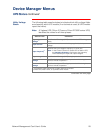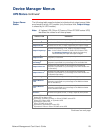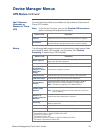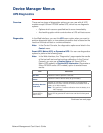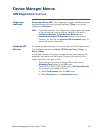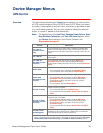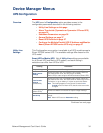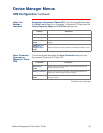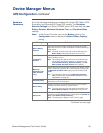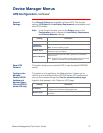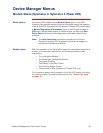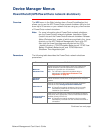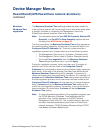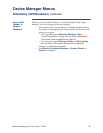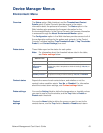
Network Management Card User’s Guide 36
Device Manager Menus
UPS Configuration FRQWLQXHG
Shutdown
Parameters
All of the following settings are available with Smart-UPS, Matrix-UPS,
Symmetra, and Symmetra 3 Phase UPS models. The
Shutdown
Behavior Settings
for a Silcon DP300E series UPS uses only the
Low-
Battery Duration
,
Maximum Shutdown TIme
, and
Shutdown Delay
settings.
Note: In the Control Console, you use the
Battery
option in the
Configuration
menu to access the
Return Battery Capacity
setting.
&RQWLQXHGRQQH[WSDJH
6HWWLQJ 'HILQLWLRQ
Return Battery
Capacity
Defines the minimum battery capacity that must be present
before the
UPS
turns on after a shutdown that was caused by a
power failure.
Note: The UPS
must also wait until the time defined by the
Return Delay
setting expires before it can turn on.
Low-Battery
Duration
Defines how the
UPS
can continue to run on battery once a low-
battery condition occurs.
Note: This setting also defines how much time PowerChute
has to safely shut down its server in response to the
Turn UPS Off Gracefully
,
Reboot Gracefully
, and
Put
UPS To Sleep Gracefully
Control
menu options.
Maximum
Shutdown Time
(Web Interface
only)
Reports the maximum time that the UPS will wait before it shuts
down in response to graceful turn-off command, as defined by
the
Maximum Shutdown TIme
setting for the PowerChute
®
option
.
Note: For information about how the
Maximum Shutdown
TIme
is determined, see Maximum-Shutdown-Time
negotiation on page 40
.
Shutdown Delay
Defines how long the
UPS
will wait before it shuts down in
response to a turn-off command.
Return Delay
Defines how long a
UPS
must wait before it turns on after a
shutdown that was caused by a power failure.
Note: The
UPS
must also have the capacity specified by the
Return Battery Capacity
setting before it can turn on.
Sleep Time
Defines how long the
UPS
will sleep (stay turned off) when you
use either one of the
Control
menu’s sleep options (
Put UPS To
Sleep
or
Put UPS To Sleep Gracefully
).
Note: This setting also appears in the “Control” page.



